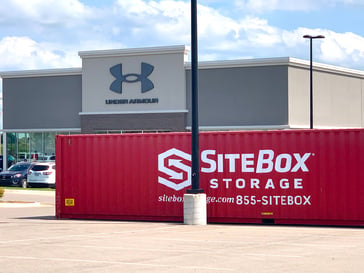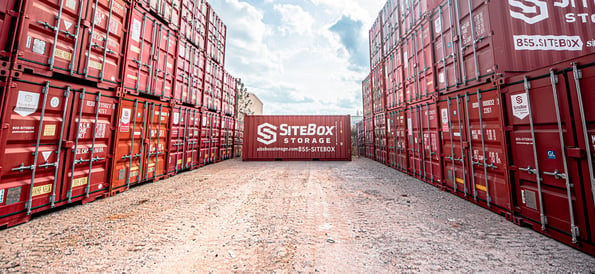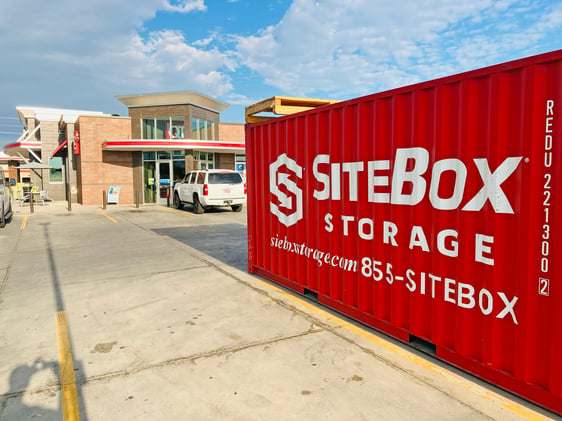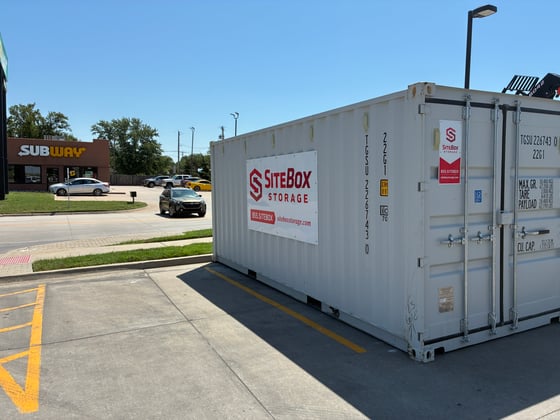Storage Container Rental Makes Sense During Restaurant Remodels

Restaurants get renovated every few years to stay current and keep customers interested. Maybe every five years, maybe ten, totally depends on your place and your vision. But let's be real: remodels are a pain. They disrupt everything. Sometimes you've got to shut down completely for weeks, which just adds stress and financial pressure to an already complicated situation.
Storage rental can seriously help with that stress. Renting safe, secure storage during your remodel minimizes the mess, keeps things running more efficiently, and helps you control costs better. A portable storage container might even let you keep serving customers while renovation work happens around you.
Here's what caught our attention: over 57% of restaurants now use storage container rentals during remodels. About 72% of restaurant owners say containers made their renovations way more efficient. And storage containers can reduce clutter by up to 90% during renovation periods. If you're planning a restaurant remodel anywhere in Ohio—Columbus, Dublin, Grove City, wherever—here's what you should know.
Assessing Your Storage Needs
Before calling anyone for pricing information, walk through your restaurant and actually figure out what needs storing. Kitchen equipment, tables, chairs, supplies, inventory, stuff from your office, decor. Everything that needs protecting or just needs to get out of the way while construction happens.
Dimensions matter more than you'd think. Large kitchen appliances eat up serious space. Commercial refrigerators, ovens, prep tables... measure your biggest items so you know what container size makes sense. Storage containers typically range from 10 to 40 feet in length. Height matters too when you're stacking boxes or storing tall equipment.

Think about your timeline honestly. How long will this remodel actually take? (Always add a buffer because projects run over.) Most rental companies offer flexible terms to match renovation schedules. Average rental costs for restaurant remodels run about $475 monthly, which beats traditional storage facilities when you factor in convenience.
Here's a stat that should get your attention: one in four restaurant remodel projects go over budget because of inadequate storage solutions. Don't become that statistic. Plan storage needs upfront and budget for them properly.
Types of Storage Containers Available
You've got several options depending on what you're trying to accomplish.
Standard containers handle most restaurant needs just fine. Ground-level access makes loading and unloading equipment way easier than dealing with ramps or lift gates. They're weather-resistant, so your stuff stays protected during Ohio winters or those intense summer storms. Secure locks keep everything safe from theft.
Climate-controlled containers maintain steady temperature and humidity levels. This matters if you're storing anything sensitive to temperature changes. Wood furniture, electronics, certain supplies... climate control prevents warping, cracking, or other damage during extended storage.
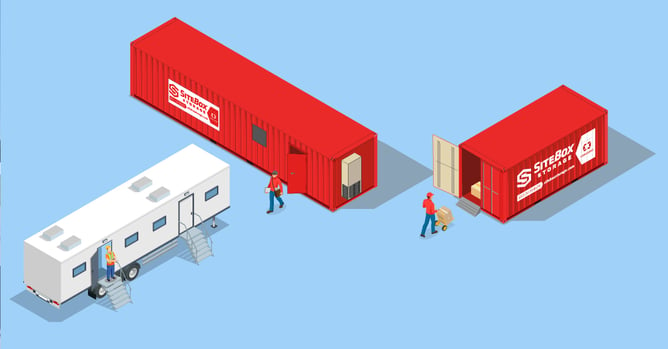
Refrigerated containers provide temporary cold storage when your commercial kitchen gets torn apart during the upgrade. You can't just throw away thousands of dollars worth of perishable inventory. Refrigerated units offer cooling options from dry cooler space all the way to deep freeze, keeping your stock safe throughout renovation.
Mobile offices give you actual functional workspace when your back office turns into a construction zone. Still need somewhere to manage orders, handle bookkeeping, schedule your team, deal with catering requests? A mobile office keeps administrative stuff running despite chaos everywhere else in the facility.
Which selection works best depends on your specific needs, budget, and how long this whole project will take.
Renting vs. Buying Storage Solutions
Renting makes way more sense for most restaurant remodels. You pay for exactly the time you need, then they pick it up when you're done. No long-term commitment, no figuring out what to do with a container sitting in your parking lot after the project wraps.
Rental companies handle delivery and pickup logistics. They drop the container wherever works for your location—parking area, driveway, side lot. Payment's usually straightforward, often available online. Some companies even offer lease-to-own if you realize you need permanent additional storage.
Buying only really makes sense if you're planning regular renovations or legitimately need extra storage space long-term. Upfront costs are way higher, though you do own the asset. For a one-time remodel? Renting wins financially almost every time.
Many providers run promotions or offer better rates for longer commitments. If your renovation stretches several months, definitely ask about extended rental pricing versus month-to-month rates.
Preparing for Your Restaurant Remodel
Preparation makes the difference between a smooth renovation and a complete disaster.
Create an actual inventory of everything you're putting in storage. List items, note their condition, maybe snap photos of valuable kitchen equipment. This protects you if anything happens and makes finding specific stuff way easier later when you need it.
Plan the layout before the container shows up. Know exactly where it'll sit on your property. Columbus and Dublin have different rules sometimes about temporary structures. Check with your city about permits or restrictions. Grove City facilities should verify local requirements too.
Coordinate timing between your contractor and container delivery. Get the storage delivered before renovation work kicks off. This gives you breathing room to move belongings and supplies before construction equipment takes over your entire facility.
Talk with your team about the plan. Your staff needs to know what's being stored where, what stays accessible, how operations will change during the remodel. Customer service can't just stop because you're renovating.
Check your insurance to make sure coverage includes items in temporary storage. Some policies cover this automatically, others don't. Way better to figure this out now than after something goes wrong.
Packing and Organizing Restaurant Items
How you organize during packing will either save you or haunt you later.
Group similar stuff together. All kitchen supplies in one section, dining room furniture in another, office belongings separate. Logical organization makes finding things infinitely easier when you desperately need something mid-renovation.
Use decent packing materials for anything fragile or expensive. Restaurant china, glassware, small appliances... wrap them right. Money spent on bubble wrap beats replacing broken inventory.
Label everything clearly. Write contents on multiple sides of boxes. When boxes get stacked (and they will), you can still see what's inside without moving half the container.
Load strategically. Heavy equipment and stuff you definitely won't need go in first, way in back. Things you might need during the remodel stay near the front for easy access. This prevents having to reorganize the entire container every time you need one item.
Keep a path down the middle if you can. Being able to walk into your storage container and reach different areas beats unloading half of everything to grab one box.
Protect kitchen equipment from dust and potential damage. Cover appliances, secure any loose parts, drain liquids. Commercial kitchen gear costs too much to be careless with it.
Managing Operations and Timeline
Containing the mess keeps your restaurant somewhat functional during renovation chaos. Storage containers give you weatherproof, pest-free space away from your dining area for storing items temporarily. Since containers are pest-proof, you can even store dry goods safely without worrying about contamination.
Having storage on-site means your team can grab supplies and equipment when needed without driving across town to some storage facility. This accessibility keeps operations running way smoother than trying to work around everything piled up in corners.
Simplifying coordination between renovation work and business operations matters more than people realize. Construction activities might mess with cooking, cleaning, customer flow, bathroom access, all kinds of vital processes. Organized storage helps contractors work efficiently while your staff tries to maintain some level of normal service.
Speeding up the work happens when contractors have a designated spot for tools and building materials. When tools are scattered randomly throughout the restaurant, everything slows down. Organized storage and clear workspace helps contractors finish faster. Time equals money during remodels. Faster renovations mean less lost revenue and less operational headaches.
Hiding the remodel from customers as much as possible protects your business. Restaurants depend on aesthetics to make dining experiences enjoyable. Remodels are messy, loud, disruptive. Storage containers help keep renovation chaos out of sight, improving what customers actually experience. The restaurant business is brutally competitive, and lots of places run on slim margins. Anything you can do to keep customers happy directly impacts your bottom line.
Safety and Security Considerations
Ground-level access cuts down safety risks significantly. No hauling heavy kitchen equipment up and down stairs. Way less chance of someone getting hurt when loading and unloading supplies.
Weather protection keeps your belongings safe from rain, snow, temperature swings. Weather-resistant containers shield expensive restaurant equipment and inventory from whatever Ohio weather decides to do.
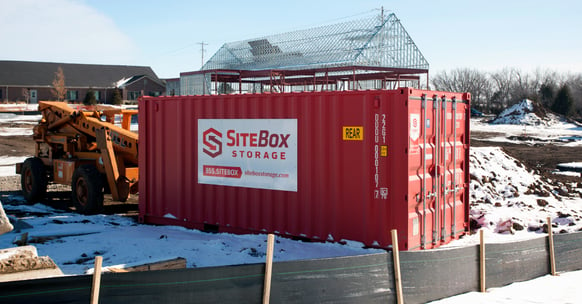
Security features really matter when you're storing pricey commercial kitchen appliances and supplies. Quality locks, solid steel construction, and being able to keep the container on your own property where you can monitor it provides serious peace of mind.
Weight limits do exist for containers, though they're pretty generous. Standard containers handle substantial loads, but if you're storing extremely heavy commercial equipment, confirm weight capacity with your rental company first.
Fire safety during renovation means keeping flammable materials properly stored and away from construction areas. Talk through safety protocols with both your contractor and rental provider.
FAQ
What sizes of storage containers are available for rent? Containers typically run from 10 to 40 feet long. Common sizes are 10', 20', and 40'. Height varies between standard and high-cube options. For restaurant remodels, 20' or 40' containers usually give you adequate space for kitchen equipment, furniture, and supplies.
How much does it cost to rent a storage container? Average costs run about $475 monthly for restaurant remodels. Prices shift based on size, features (climate control costs extra), location, and how long you're renting. Delivery and pickup add another $200-400 usually. Get detailed quotes with all fees from providers in your area.
How long can I rent the storage container for? Rental periods are flexible. Most companies do month-to-month with no long-term contract. Rent for a few weeks, several months, whatever your renovation needs. Some providers give better rates for longer rentals.
Where can I place the storage container during my remodel? Containers can go in parking lots, driveways, or open spaces on your property. You need relatively level ground and clearance for delivery trucks (about 100 feet). Check with your city about permits or temporary structure restrictions. Most places allow them without issues, but rules vary.
Do storage containers come with insurance coverage? Insurance varies by company. Some include basic coverage in rental agreements, others offer it as extra. Check whether your business insurance covers items in temporary storage. If not, consider buying coverage through your rental provider for protection.
Can I access my items in the storage container? Yes, containers on your property give you 24/7 access. You control the keys and can get items whenever needed. This beats off-site storage facilities with limited hours by a mile.
What items should I store in a rental container during renovations? Store furniture, kitchen equipment not currently in use, extra supplies, inventory, office stuff, decor items, anything needing protection from construction dust and damage. Dry goods work fine in pest-proof containers. Perishables need refrigerated units.
Are there any weight limits for rented storage containers? Standard containers handle serious weight, usually several thousand pounds. For extremely heavy commercial kitchen equipment, confirm capacity with your provider. They'll recommend appropriate container types based on what you're storing.
How do I schedule delivery and pickup of the container? Contact your rental company to schedule both. Give them your restaurant address, where you want it placed, and your timeline. Most companies deliver within days of your request. Schedule pickup after renovation completes and you've moved everything back inside.
Is there a difference between short-term and long-term rentals? Pricing structures differ. Short-term rentals (under 3 months) might have higher monthly rates but more flexibility. Long-term rentals (3+ months) typically offer better monthly pricing. Some companies run promotions for longer commitments. Compare based on your expected timeline.
